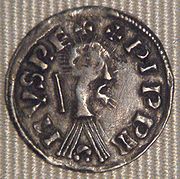
French denier
Encyclopedia


Franks
The Franks were a confederation of Germanic tribes first attested in the third century AD as living north and east of the Lower Rhine River. From the third to fifth centuries some Franks raided Roman territory while other Franks joined the Roman troops in Gaul. Only the Salian Franks formed a...
coin
Coin
A coin is a piece of hard material that is standardized in weight, is produced in large quantities in order to facilitate trade, and primarily can be used as a legal tender token for commerce in the designated country, region, or territory....
created by Charlemagne
Charlemagne
Charlemagne was King of the Franks from 768 and Emperor of the Romans from 800 to his death in 814. He expanded the Frankish kingdom into an empire that incorporated much of Western and Central Europe. During his reign, he conquered Italy and was crowned by Pope Leo III on 25 December 800...
in the Early Middle Ages
Early Middle Ages
The Early Middle Ages was the period of European history lasting from the 5th century to approximately 1000. The Early Middle Ages followed the decline of the Western Roman Empire and preceded the High Middle Ages...
. It was introduced together with an accounting system in which twelve deniers equaled one sou
Solidus (coin)
The solidus was originally a gold coin issued by the Romans, and a weight measure for gold more generally, corresponding to 4.5 grams.-Roman and Byzantine coinage:...
and twenty sous equalled one livre
French livre
The livre was the currency of France until 1795. Several different livres existed, some concurrently. The livre was the name of both units of account and coins.-Etymology:...
. This system and the denier itself served as the model for many of Europe's currencies, including the British pound, Italian lira
Italian lira
The lira was the currency of Italy between 1861 and 2002. Between 1999 and 2002, the Italian lira was officially a “national subunit” of the euro...
, Spanish peseta
Spanish peseta
The peseta was the currency of Spain between 1869 and 2002. Along with the French franc, it was also a de facto currency used in Andorra .- Etymology :...
and the Portuguese dinheiro
Portuguese dinheiro
The dinheiro was the currency of Portugal from around the late 12th century until approximately 1502. For accounting purposes, twelve dinheiros equalled one soldo and twenty soldos equal one libra....
.
The British equivalent of the denier was the penny
Penny
A penny is a coin or a type of currency used in several English-speaking countries. It is often the smallest denomination within a currency system.-Etymology:...
, 240 of which (prior to decimalisation
Decimal Day
Decimal Day was the day the United Kingdom and Ireland decimalised their currencies.-Old system:Under the old currency of pounds, shillings and pence, the pound was made up of 240 pence , with 12 pence in a shilling and 20 shillings in a...
) made up one British pound or 20 shilling
Shilling
The shilling is a unit of currency used in some current and former British Commonwealth countries. The word shilling comes from scilling, an accounting term that dates back to Anglo-Saxon times where it was deemed to be the value of a cow in Kent or a sheep elsewhere. The word is thought to derive...
s. The symbol for both the old denier and, until decimalisation, the penny
Penny
A penny is a coin or a type of currency used in several English-speaking countries. It is often the smallest denomination within a currency system.-Etymology:...
used in the United Kingdom
United Kingdom
The United Kingdom of Great Britain and Northern IrelandIn the United Kingdom and Dependencies, other languages have been officially recognised as legitimate autochthonous languages under the European Charter for Regional or Minority Languages...
and elsewhere was "d".
The name denier was derived from the name of the Roman coin
Roman currency
The Roman currency during most of the Roman Republic and the western half of the Roman Empire consisted of coins including the aureus , the denarius , the sestertius , the dupondius , and the as...
the denarius
Denarius
In the Roman currency system, the denarius was a small silver coin first minted in 211 BC. It was the most common coin produced for circulation but was slowly debased until its replacement by the antoninianus...
.
Gold denier
Most deniers were silver, but a gold one has been found and is included in a German exhibition.See also
- denar
- dinarDinarThe dinar is the official currency of several countries.The history of the dinar dates to the gold dinar, an early Islamic coin corresponding to the Byzantine denarius auri...
- dineroSpanish dineroThe dinero was the currency of the Christian states of Spain from the 11th century. It was copied from the French denier and served in turn as the model for the Portuguese dinheiro....
- pfennigPfennigThe Pfennig , plural Pfennige, is an old German coin or note, which existed from the 9th century until the introduction of the euro in 2002....

